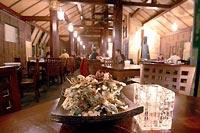Big spoonfuls of spicy Thai goodness at May

Many restaurants in Thailand operate in old teak houses. May Chaleoy, wanting to re-create the experience in Seattle, did what anyone would do: She went to Thailand and came back to Wallingford with a teak house. But that wasn't what impressed me when I first sat down at her restaurant, which she co-owns with veteran restaurateur James Weimann (of Peso's and the Triangle) and partner Auzie Oxford. No, it was the spoons.
In Thailand, the utensils of choice are a fork and spoon, and it's the spoon that goes in your mouth. Thai spoons are huge. So when I saw a big brass spoon at my place setting at May, I expected serious eating, and I wasn't disappointed. My oversized spoon made its way through May's small menu and found a number of exciting and fiery dishes.
First, though, let's talk about that house. A curved stairway leads up into the restaurant proper, which wisely avoids too much in the way of knickknacks and lets the house speak for itself. OK, there are photos of the Thai royal family and a Buddha or two, and in December the worst-ever Christmas mix was playing over the stereo, but forget all that. Look around at the teak walls and tell yourself, "I am in Thailand." Then, when your food emerges from behind the kitchen shutters, prepare to burn your tongue in an authentic manner, because May doesn't ask you, "How many stars?" and defaults to three or four.
Bargain them down only if you must.
Start with the yum pug boong ($6), made with a vegetable here called Siamese watercress (often referred to as water spinach and recognizable by its tender, hollow stems). The crisp greens are dipped in batter and fried, then topped with a thick chili sauce. Every aspect of this dish has been optimized for pleasure. When I sent the yum pug boong down the table and saw it being depleted, I despaired. Luckily, someone passed me the pla meuk yang ($5), slices of tender squid in a hot and sour sauce.
It may not sound like high praise to say that one of May's strengths is not overcooking, but that's the usual fate of seafood in Thai restaurants. The hoi pud gra pao ($15) sounded like a minefield: clams, mussels and scallops with holy basil. But the seafood was perfectly cooked, especially the luscious scallops.
Gai yang (grilled chicken, $12) also came off the grill at just the right time. If there's a better way to prepare chicken than marinating it with lemongrass and coconut milk, braising it in a pan, then grilling it, I don't know about it.
There is pad Thai here ($10), and it is very good, but the accompaniments set it apart. Alongside the tangle of noodles you'll find Chinese chives and a banana blossom, a phallic purple vegetable that is the most tannic thing you'll ever eat. The idea, I gather, is that it makes a perfect palate cleanser: When your mouth is filmed with oil from the noodles, one little nibble of banana blossom will clear that right up.
Unfortunately, this marginally edible garnish is one of the only vegetables in evidence at May. While Thai cuisine is replete with vegetable dishes, the only vegetable-heavy entrees here are an unremarkable green-bean stir-fry (pud prik khing, $11), and an asparagus and tofu dish (pud nor mai farang, $12) that I didn't try, because it's against my religion to eat asparagus in January.
The quality of service at May depends on where you sit. Upstairs, every dish arrived promptly, and everyone was friendly and informed. Downstairs in the bar, service is scatterbrained. "What would you guys like to drink?" the bartender asked, two minutes after we ordered drinks. Off a drink menu that we had to request twice. But it's worth braving the bar during happy hour (5-7 p.m. and 11 p.m.-1 a.m.), when a variety of appetizers are served for a set price of $9 in pin-to boxes (similar to those stacking Chinese lunch boxes); the selection includes options not on the regular menu, such as a sour, spicy northeastern Thai bamboo-shoot salad called soup nor mai.
On either floor, you can sample May's excellent specialty cocktails ($8, or $4 during happy hour), such as the Lemon Grass Gimlet and the Cucumber Kazi (based on cucumber vodka, with a floating cucumber slice).
Desserts at May are Thai-inspired rather than traditional Thai, which is fine — I'd rather have May's molten chocolate cake ($7), spiced with cinnamon and cayenne, than a less-than-perfect mango. A rich crème brûlée ($6) is served with small spoonfuls of lime-scented pineapple confit. On one visit it was properly caramelized; the next, burnt.
At last count, there are 10 billion Thai restaurants in Seattle, and I've been to at least half of them. There is simply nothing else like May in town. There are a handful of hole-in-the-wall neighborhood restaurants that occasionally achieve the kind of flavor and texture balance characteristic of good restaurants in Thailand. But there is no other place that gets it right so often and in such lovely surroundings.
In the end, my only real complaint about May is that awful Christmas music they played in December. Now that the holidays are over, there is no reason not to go.
Matthew Amster-Burton: mamster@mamster.net
|